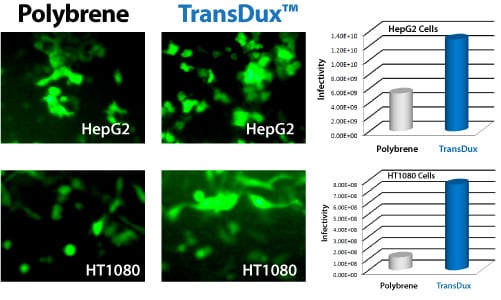TransDux™ (Original) Virus Transduction Reagent
- High transduction efficiency
- Broad cell type compatibility
- Minimal hands-on time
Products
| Catalog Number | Description | Size | Price | Quantity | Add to Cart | |||
|---|---|---|---|---|---|---|---|---|
| LV850A-1 | TransDux virus transduction reagent (200x) | 100 Transductions | $358 |
|
||||
Overview
Overview
Infect more cells with TransDux™
Increase your transduction efficiencies with TransDux (Original) Virus Transduction Reagent. Simply mix with virus to see 2-fold or greater (depending on cell type) transduction efficiencies over polybrene addition.
Or try our newer TransDux MAX™ Virus Transduction Reagent for an even greater increase in infectivity.
- High transduction efficiency
- Broad cell type compatibility
- Minimal hands-on time
References
How It Works
How It Works
Get higher transduction efficiencies with minimal hands-on time
Simply combine culture medium with TransDux to a final concentration of 1x, add to cells, and then add virus. Swirl to mix, and proceed with the transduction as usual—72-hours post transduction, the viral genome will be integrated into the host cell genome.
Supporting Data
Supporting Data
Increase transduction efficiencies with TransDux
Figure 1. Our original TransDux Reagent increases transduction efficiencies at least 2-fold compared to polybrene. Transduction of either HepG2 cells (top panels) or HT1080 cells (bottom panels) with the addition of polybrene (left two panels) or TransDux (middle two panels). The right two panels show quantitative measures of infectivity using the Global UltraRapid Titer Kit. Both imaging and infectivity data show that TransDux increased the infectivity of lentivirus in both cell types as compared to polybrene.
FAQs
Documentation
Citations
Related Products
Products
| Catalog Number | Description | Size | Price | Quantity | Add to Cart | |||
|---|---|---|---|---|---|---|---|---|
| LV850A-1 | TransDux virus transduction reagent (200x) | 100 Transductions | $358 |
|
||||
Overview
Overview
Infect more cells with TransDux™
Increase your transduction efficiencies with TransDux (Original) Virus Transduction Reagent. Simply mix with virus to see 2-fold or greater (depending on cell type) transduction efficiencies over polybrene addition.
Or try our newer TransDux MAX™ Virus Transduction Reagent for an even greater increase in infectivity.
- High transduction efficiency
- Broad cell type compatibility
- Minimal hands-on time
References
How It Works
How It Works
Get higher transduction efficiencies with minimal hands-on time
Simply combine culture medium with TransDux to a final concentration of 1x, add to cells, and then add virus. Swirl to mix, and proceed with the transduction as usual—72-hours post transduction, the viral genome will be integrated into the host cell genome.
Supporting Data
Supporting Data
Increase transduction efficiencies with TransDux
Figure 1. Our original TransDux Reagent increases transduction efficiencies at least 2-fold compared to polybrene. Transduction of either HepG2 cells (top panels) or HT1080 cells (bottom panels) with the addition of polybrene (left two panels) or TransDux (middle two panels). The right two panels show quantitative measures of infectivity using the Global UltraRapid Titer Kit. Both imaging and infectivity data show that TransDux increased the infectivity of lentivirus in both cell types as compared to polybrene.

